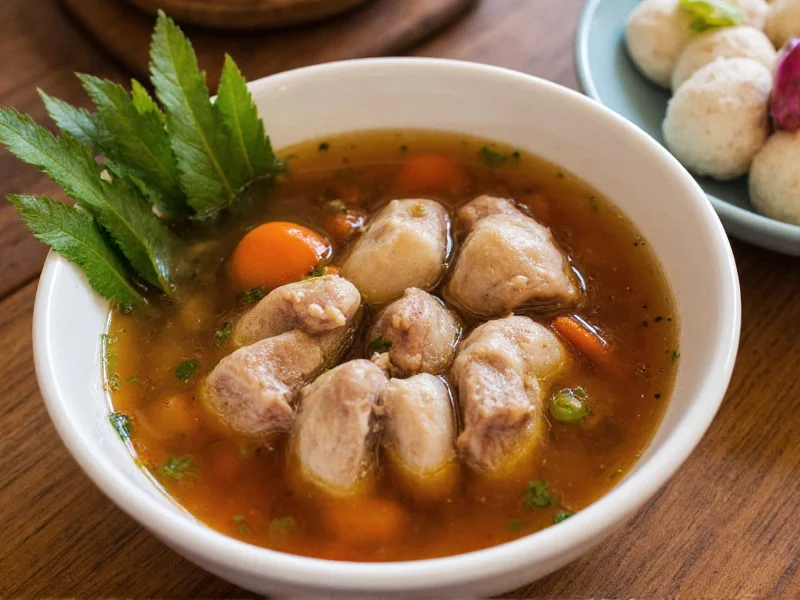Pork bone broth soup represents one of the world's most enduring culinary traditions, valued across Asian, European, and American cuisines for both its rich flavor profile and substantial nutritional properties. When prepared correctly using quality bones and proper technique, this broth delivers essential amino acids like glycine and proline, along with minerals including calcium, magnesium, and phosphorus that become bioavailable through extended simmering.
The Science Behind Pork Bone Broth Benefits
Unlike store-bought alternatives, homemade pork bone broth soup contains naturally occurring collagen that converts to gelatin during cooking. This transformation creates a substance that research indicates supports digestive health by improving gut lining integrity. The extended cooking process—typically 12-24 hours—allows for maximum extraction of nutrients from both bones and connective tissues.
Professional chefs and nutrition experts agree that the quality of your starting ingredients directly impacts the final product. For optimal results when making pork bone broth soup from scratch, select bones with ample connective tissue like knuckles, feet, or neck bones. These cuts contain higher concentrations of collagen compared to standard meat bones.
Traditional Preparation Method
Creating authentic pork bone broth soup requires attention to detail throughout the process. Begin by roasting bones at 400°F (200°C) for 30-40 minutes to develop flavor through the Maillard reaction. After roasting, transfer bones to a large stockpot and cover with cold water—never hot, as this helps extract impurities gradually.
Add two tablespoons of apple cider vinegar to the pot before heating. This acidic component helps draw minerals from the bones during simmering. Bring to a gentle boil, then immediately reduce to the lowest possible simmer. Skim any foam that rises to the surface during the first 30 minutes of cooking.
| Nutrient | Amount per Cup | Primary Health Benefit |
|---|---|---|
| Collagen/Gelatin | 5-10g | Supports joint health and skin elasticity |
| Glycine | 1.5-2g | Aids digestion and supports liver detoxification |
| Calcium | 50-100mg | Essential for bone health |
| Magnesium | 10-20mg | Supports muscle and nerve function |
| Glucosamine | Trace amounts | Promotes cartilage health |
Simmering Time Considerations
The ideal simmering time for pork bone broth soup ranges from 12 to 24 hours, depending on your equipment and desired concentration. Pressure cookers can reduce this to 2-3 hours while maintaining nutrient extraction. Extended cooking beyond 24 hours yields diminishing returns and may create off-flavors.
During cooking, maintain a gentle simmer where bubbles occasionally break the surface—vigorous boiling creates cloudy broth and can break down delicate nutrients. Periodically check water levels and add hot water as needed to keep bones submerged.
Cultural Variations Across Cuisines
Pork bone broth forms the foundation of numerous traditional dishes worldwide. In Chinese cuisine, it serves as the base for tonkotsu-style soups with added aromatics like ginger and star anise. Vietnamese pho often incorporates pork bones alongside beef for complex flavor profiles. European charcuterie traditions use pork bone broth in rich sauces and pâtés.
Regional differences primarily appear in seasoning approaches rather than fundamental preparation. Asian variations typically include ginger, garlic, and scallions added early in cooking, while European preparations might incorporate bay leaves, thyme, and parsley stems. The core technique of extended simmering remains consistent across culinary traditions.
Common Preparation Mistakes
Many home cooks encounter issues when making pork bone broth soup due to preventable errors. Adding salt too early can draw out moisture from bones before nutrients have properly extracted. Starting with hot water prevents proper impurity removal during initial heating. Using exclusively meaty bones creates broth with excessive fat and insufficient gelatin.
For clearer broth, avoid stirring during cooking and maintain that gentle simmer. When straining, use a fine-mesh sieve lined with cheesecloth for optimal clarity. Never skip the roasting step for deeper flavor development—this simple technique creates complex flavor compounds through caramelization.
Storage and Culinary Applications
Properly stored pork bone broth soup maintains quality for up to 5 days in the refrigerator or 6 months in the freezer. For convenient use, freeze portions in ice cube trays then transfer to airtight containers. The ideal broth should gel when chilled, indicating proper collagen extraction.
Beyond traditional soup applications, pork bone broth enhances numerous dishes. Use it as the liquid component in risotto for added richness, deglaze pans for superior pan sauces, or substitute for water when cooking grains. Chefs increasingly recognize its value for improving texture and flavor in everything from braises to baked goods.
Frequently Asked Questions
How long should I simmer pork bones for optimal broth?
For maximum nutrient extraction, simmer pork bones for 12-24 hours. The extended time allows collagen to fully convert to gelatin and minerals to dissolve into the liquid. Pressure cookers can achieve similar results in 2-3 hours. The broth should gel when chilled, indicating proper collagen extraction.
Can I use pork bone broth soup for gut health improvement?
Yes, pork bone broth contains gelatin and amino acids like glycine that support gut lining integrity. Regular consumption may help maintain healthy digestive function by providing building blocks for intestinal cell repair. For best results, consume 1-2 cups daily as part of a balanced diet.
What's the difference between pork bone broth and stock?
Pork bone broth simmers bones for extended periods (12-24 hours) to extract collagen and minerals, creating a gelatinous texture when chilled. Stock typically cooks for shorter durations (3-4 hours) with more meat attached, resulting in richer flavor but less gelatin. Broth emphasizes nutritional benefits while stock focuses on immediate flavor contribution.
Which pork bones work best for making broth?
Bones with high connective tissue content produce superior broth. Knuckles, feet, and neck bones contain abundant collagen that converts to gelatin during cooking. Avoid using primarily meaty cuts, as they contribute flavor but minimal gelatin. A combination of marrow bones and connective tissue-rich bones creates balanced flavor and texture.











 浙公网安备
33010002000092号
浙公网安备
33010002000092号 浙B2-20120091-4
浙B2-20120091-4